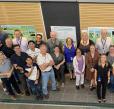Investigating advanced materials for large scale energy storage
New cathode material provides a direction for the design of high performing sodium ion batteries for large scale energy storage

Showing 2501 - 2520 of 3118 results
New cathode material provides a direction for the design of high performing sodium ion batteries for large scale energy storage
ANSTO’s Innovation Precinct has been highlighted in the Greater Sydney Commission’s South District Plan.

Applications, Recent results, Publications.

Recent news, highlights, and impact case studies from CAS’ research and industry user communities and collaborations/partners
Neutron scattering has contributed to a 'tour de force' of chemistry led by Monash University.
This science week ANSTO is releasing a new way for students across Australia to learn about the periodic table of elements with augmented reality (AR). ANSTO's Free AR experience unlocks the periodic table to reveal a world of protons, neutrons and electrons and illustrates how useful they are to science and industry in the 21st century.
ANSTO has contributed to the internationally-distributed handbook on plutonium published by the American Nuclear Society.
Health researchers meet with total-body PET Explorer Consortium team.in US.
Part of the Large Hardon Collider
The Graduate Institute is part of ANSTO’s Innovation Precinct and links all graduates together to create a network of Australia’s brightest young minds focused on the future.
ANSTO shared expertise on next-generation reactors and nuclear power with sustainable energy experts at the Australian Academy of Science symposium in May.

Our Year 11 Chemistry tour and depth study guide can be used as the starting point for a depth study about nuclear science, covering nuclear-related components of Module 1: Properties of Structure and Matter.
All tours are available Monday to Friday for Years 7 to 12 classes.
The cost per student is $12.50 and teachers are free.
Teachers are requested to print enough copies of the relevant workbook for their class before their visit to ANSTO, as students will not be permitted to bring digital devices on-site.
Building a stable tower out of paper and designing a bionic limb were among the challenges of the Discover Engineering day, held on 11 May at ANSTO.
International palaeontologists have used advanced imaging techniques at ANSTO’S Australian Synchrotron to clarify the role that the earliest fruit-eating birds of the Cretaceous period may have had in helping fruit-producing plants to evolve.